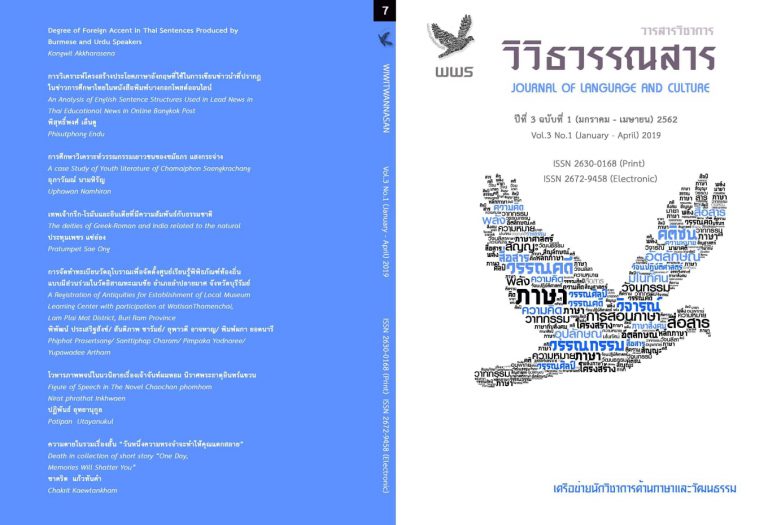Degree of Foreign Accent in Thai Sentences Produced by Burmese and Urdu Speakers
Main Article Content
Abstract
This study aims to analyze degree of foreign accent in Thai sentences produced by native Burmese speakers (NB) and native Urdu speakers (NU). The two groups are the representatives of native speakers of tonal language and non-tonal language. The perceived foreign accent of the participant was rated by Bangkok people with a 5-score Likert Scale. The data were collected from 100 connected speech sentences; forty sentences from NB, forty sentences from NU, and twenty sentences from native Thai speakers (NT).
The data were analyzed statistically to find out for Mean, Standard Deviation, and One-Way ANOVA with LSD. The result revealed that Thai sentences produced by NB and NU were significantly distinctive from those of NT. Moreover, the scores of individual speakers indicated that both NB and NU were rated at different levels according to their detectable foreign accents. The overall results showed that regardless of whether one’s native language is tonal or non-tonal; this is not the factor in determining how well they are able to articulate Thai language correctly.
Article Details
Copyright is that of the journal any reproduction must be permitted by the editor of journal
References
of Burmese and Urdu. Vacana Journal of Language and Linguistics,3(2): 1–23.
Ali, R. (2014, July 15). Packing Their Bags: Christians Moving to Thailand to
Escape Violence, Insecurity. Retrieved from https://tribune.com.pk/
story/735724/packing-their-bags-christians-moving-to-thailand-to-es
cape-violence-/
Derwing, T. M., Thomson, R. I., & Munro, M. J. (2006). English Pronunciation
and Fluency Development in Mandarin and Slavic Speakers. System,
34(2): 183–193.
Kittisurakosol, D. (2012). Variation of Nasal Consonants in Thai Spoken
by Koreans in Thailand. (Unpublished Master’s thesis). Thammasat
University, Bangkok.
Nguyen, T. V. C. (2006). A Comparative Study of Acoustic Characteristics of
Thai Tones Spoken by Vietnamese According to Language Experiences.
(Unpublished Master’s thesis). Srinakharinwirot University, Bangkok.
Panam, A., Zaw, K. M. K., Caouette, T., & Punpuing, S. (2004). Migrant Do
mestic Workers: From Burma to Thailand. Salaya, Nakhonpathom:
Institute for Population and Social Research, Mahidol University.
Sinthawashewa, T. (2009). The Bangkok Thai Tones Produced by Japanese
Speakers: An Acoustic and Perception Study.(Unpublished Master’s
thesis). Chulalongkorn University, Bangkok.
Steinberg, D., Nagata, H. & Aline, D. (2001). Psycholinguistics: Language, Mind
and World. (2nd ed.). London: Longman.
Sutthijetsadarot, P. (2012). English Speakers’ Judgment of Non-native
Production in Different Styles by Thais.(Unpublished Master’s
thesis). Thammasat University, Bangkok.
UNHCR-The UN Refugee Agency. (n.d.). 2015 UNHCR Country Operations
Profile–Thailand. Retrieved from https://www.unhcr.org/
pages/49e489646.html
Wayland, R. & Guion, S. G. (2004). Training English and Chinese Listeners to
Perceive Thai Tones: A Preliminary Report. Language Learning, 54(4):
681–712.
Yip, M. (2007). Tone. In P. de lacy. (Ed.), The Cambridge Handbook of
Phonology (pp. 229–252). Cambridge: Cambridge University Press.
Zinck, T. (2007). Production of Thai Tones and Vowels by Native Speaking
Students in the Thai Studied Program at Thammasat University.
(Unpublished Master’s thesis). Thammasat University, Bangkok.


